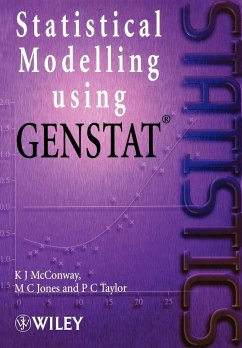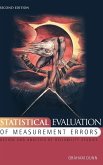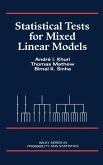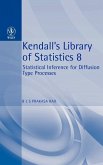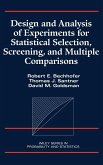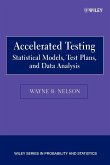- Broschiertes Buch
- Merkliste
- Auf die Merkliste
- Bewerten Bewerten
- Teilen
- Produkt teilen
- Produkterinnerung
- Produkterinnerung
The complete guide to statistical modelling with GENSTAT Focusing on solving practical problems and using real datasets collected during research of various sorts, Statistical Modelling Using GENSTAT emphasizes developing and understanding statistical tools. Throughout the text, these statistical tools are applied to answer the very questions the original researchers sought to answer. GENSTAT, the powerful statistical software, is introduced early in the book and practice problems are carried out using the software, in the process helping students to understand the application of statistical methods to real-world data.…mehr
Andere Kunden interessierten sich auch für
![Statistics in Finance Statistics in Finance]() David J HandStatistics in Finance86,99 €
David J HandStatistics in Finance86,99 €![Statistical Evaluation of Measurement Errors Statistical Evaluation of Measurement Errors]() Graham DunnStatistical Evaluation of Measurement Errors97,99 €
Graham DunnStatistical Evaluation of Measurement Errors97,99 €![Statistical Tests for Mixed Linear Models Statistical Tests for Mixed Linear Models]() André I KhuriStatistical Tests for Mixed Linear Models197,99 €
André I KhuriStatistical Tests for Mixed Linear Models197,99 €![Statistical Inference for Diffusion Type Processes Statistical Inference for Diffusion Type Processes]() B L S Prakasa RaoStatistical Inference for Diffusion Type Processes125,99 €
B L S Prakasa RaoStatistical Inference for Diffusion Type Processes125,99 €![Design and Analysis of Experiments for Statistical Selection, Screening, and Multiple Comparisons Design and Analysis of Experiments for Statistical Selection, Screening, and Multiple Comparisons]() Robert E BechhoferDesign and Analysis of Experiments for Statistical Selection, Screening, and Multiple Comparisons218,99 €
Robert E BechhoferDesign and Analysis of Experiments for Statistical Selection, Screening, and Multiple Comparisons218,99 €![Accelerated Testing Accelerated Testing]() Wayne B NelsonAccelerated Testing151,99 €
Wayne B NelsonAccelerated Testing151,99 €![Experiments with Mixtures Experiments with Mixtures]() John A CornellExperiments with Mixtures191,99 €
John A CornellExperiments with Mixtures191,99 €-
-
-
The complete guide to statistical modelling with GENSTAT Focusing on solving practical problems and using real datasets collected during research of various sorts, Statistical Modelling Using GENSTAT emphasizes developing and understanding statistical tools. Throughout the text, these statistical tools are applied to answer the very questions the original researchers sought to answer. GENSTAT, the powerful statistical software, is introduced early in the book and practice problems are carried out using the software, in the process helping students to understand the application of statistical methods to real-world data.
Produktdetails
- Produktdetails
- Verlag: Wiley
- Seitenzahl: 512
- Erscheinungstermin: 27. August 1999
- Englisch
- Abmessung: 244mm x 170mm x 27mm
- Gewicht: 877g
- ISBN-13: 9780470685686
- ISBN-10: 0470685689
- Artikelnr.: 27986143
- Herstellerkennzeichnung
- Libri GmbH
- Europaallee 1
- 36244 Bad Hersfeld
- gpsr@libri.de
- Verlag: Wiley
- Seitenzahl: 512
- Erscheinungstermin: 27. August 1999
- Englisch
- Abmessung: 244mm x 170mm x 27mm
- Gewicht: 877g
- ISBN-13: 9780470685686
- ISBN-10: 0470685689
- Artikelnr.: 27986143
- Herstellerkennzeichnung
- Libri GmbH
- Europaallee 1
- 36244 Bad Hersfeld
- gpsr@libri.de
K. J. McConway and M. C. Jones are the authors of Statistical Modelling Using Genstat, published by Wiley.
Preface ix
Introduction 1
What methods will this book cover? 2
Exploring an interesting dataset 4
A brief outline of the book 11
Review of statistical concepts 13
The normal distribution 13
Basic attributes 13
Data and the normal distribution 15
Transforming to normality 19
Some distributional properties 21
Confidence intervals 21
Confidence interval for the mean of a normal distribution; Student's t
distribution 22
Hypothesis testing 24
The one-sample t test 25
The two sample t test 28
Chi-squared and F distributions 30
The ¿2 distribution 30
The F distribution 31
Bernoulli, binomial and Poisson distributions 32
The Bernoulli distribution 32
The binomial distribution 33
The Poisson distribution 34
Maximum likelihood estimation 36
The central limit theorem 38
Categorical and quantitative variables 40
Introduction to GENSTAT 43
Getting started 43
Loading, storing, retrieving and manipulating data 49
Summaries and graphics 54
Using the help system 60
Searching for help on a topic 60
Genstat Language Reference 61
The help system 62
Some useful hints about GENSTAT 63
Linear regression with one explanatory variable 65
The simple linear regression model 65
Fitting lines and making inferences 71
Confidence intervals and prediction 78
Checking the assumptions 83
Transformations 87
Comparing slopes 93
A look forward 96
Correlation 97
One-way analysis of variance 103
Regression with a continuous response variable and a categorical
explanatory variable 103
One-way ANOVA: data and model 110
The completely randomized experiment 110
The basic one-way analysis of variance model 113
Testing for equality of means 116
Checking the model 123
Differences between treatments 129
Planned comparisons and contrasts 129
Unplanned comparisons 133
A final example 134
Multiple linear regression 137
Using the model 138
Choosing explanatory variables 145
Parallels with the case of one explanatory variable 156
Using indicator variables I: comparing regression lines 159
Using indicator variables II: analysis of variance 163
The analysis of factorial experiments 169
Two-way factorial analysis of variance 169
The basics: main effects and interactions 169
Developing the methods 177
More than two factors 181
Using regression 186
Factorial ANOVA without replication 192
Experiments with blocking 197 (
Blocking 197
Paired data 198
More than two units per block 200
More complicated blocking 208
Latin squares 208
Incomplete block designs 211
Factorial experiments with incomplete blocks 215
Split plot designs 216
Confounding 219
Designing experiments 222
Binary regression 225
The logistic function 226
The logistic regression model 232
Using the logistic regression model 234
Exercises in logistic regression 241
What are generalized linear models? 247
Poisson regression 247
The generalized linear model 252
Inference for GLMs 254
A short history of GLMs 260
Some more GLM applications 261
Mixing insecticides 261
Toxoplasmosis and rainfall 265
Survival of leukaemia patients 266
Janka hardness revisited 268
Diagnostic checking 273
Leverage 273
The Cook statistic 278
Diagnostics for generalized linear models 282
Residuals for generalized linear models 283
Detection of observations with high leverage or influence 288
Recommended use of model diagnostics 291
Loglinear models for contingency tables 293
Two-way contingency tables 294
Sampling models 297
Loglinear models in practice 303
Logistic and loglinear models 313
Further data analyses 317
Agglomeration of alumina 317
Prostatic cancer 321
Ground cover and apple trees 324
Epileptic seizures 328
Postscript 335
Ordinal responses 335
Smoothing: generalized additive models 336
Censoring in survival data 338
Solutions to the Exercises 341
Index of datasets 497
Subject index 499
Introduction 1
What methods will this book cover? 2
Exploring an interesting dataset 4
A brief outline of the book 11
Review of statistical concepts 13
The normal distribution 13
Basic attributes 13
Data and the normal distribution 15
Transforming to normality 19
Some distributional properties 21
Confidence intervals 21
Confidence interval for the mean of a normal distribution; Student's t
distribution 22
Hypothesis testing 24
The one-sample t test 25
The two sample t test 28
Chi-squared and F distributions 30
The ¿2 distribution 30
The F distribution 31
Bernoulli, binomial and Poisson distributions 32
The Bernoulli distribution 32
The binomial distribution 33
The Poisson distribution 34
Maximum likelihood estimation 36
The central limit theorem 38
Categorical and quantitative variables 40
Introduction to GENSTAT 43
Getting started 43
Loading, storing, retrieving and manipulating data 49
Summaries and graphics 54
Using the help system 60
Searching for help on a topic 60
Genstat Language Reference 61
The help system 62
Some useful hints about GENSTAT 63
Linear regression with one explanatory variable 65
The simple linear regression model 65
Fitting lines and making inferences 71
Confidence intervals and prediction 78
Checking the assumptions 83
Transformations 87
Comparing slopes 93
A look forward 96
Correlation 97
One-way analysis of variance 103
Regression with a continuous response variable and a categorical
explanatory variable 103
One-way ANOVA: data and model 110
The completely randomized experiment 110
The basic one-way analysis of variance model 113
Testing for equality of means 116
Checking the model 123
Differences between treatments 129
Planned comparisons and contrasts 129
Unplanned comparisons 133
A final example 134
Multiple linear regression 137
Using the model 138
Choosing explanatory variables 145
Parallels with the case of one explanatory variable 156
Using indicator variables I: comparing regression lines 159
Using indicator variables II: analysis of variance 163
The analysis of factorial experiments 169
Two-way factorial analysis of variance 169
The basics: main effects and interactions 169
Developing the methods 177
More than two factors 181
Using regression 186
Factorial ANOVA without replication 192
Experiments with blocking 197 (
Blocking 197
Paired data 198
More than two units per block 200
More complicated blocking 208
Latin squares 208
Incomplete block designs 211
Factorial experiments with incomplete blocks 215
Split plot designs 216
Confounding 219
Designing experiments 222
Binary regression 225
The logistic function 226
The logistic regression model 232
Using the logistic regression model 234
Exercises in logistic regression 241
What are generalized linear models? 247
Poisson regression 247
The generalized linear model 252
Inference for GLMs 254
A short history of GLMs 260
Some more GLM applications 261
Mixing insecticides 261
Toxoplasmosis and rainfall 265
Survival of leukaemia patients 266
Janka hardness revisited 268
Diagnostic checking 273
Leverage 273
The Cook statistic 278
Diagnostics for generalized linear models 282
Residuals for generalized linear models 283
Detection of observations with high leverage or influence 288
Recommended use of model diagnostics 291
Loglinear models for contingency tables 293
Two-way contingency tables 294
Sampling models 297
Loglinear models in practice 303
Logistic and loglinear models 313
Further data analyses 317
Agglomeration of alumina 317
Prostatic cancer 321
Ground cover and apple trees 324
Epileptic seizures 328
Postscript 335
Ordinal responses 335
Smoothing: generalized additive models 336
Censoring in survival data 338
Solutions to the Exercises 341
Index of datasets 497
Subject index 499
Preface ix
Introduction 1
What methods will this book cover? 2
Exploring an interesting dataset 4
A brief outline of the book 11
Review of statistical concepts 13
The normal distribution 13
Basic attributes 13
Data and the normal distribution 15
Transforming to normality 19
Some distributional properties 21
Confidence intervals 21
Confidence interval for the mean of a normal distribution; Student's t
distribution 22
Hypothesis testing 24
The one-sample t test 25
The two sample t test 28
Chi-squared and F distributions 30
The ¿2 distribution 30
The F distribution 31
Bernoulli, binomial and Poisson distributions 32
The Bernoulli distribution 32
The binomial distribution 33
The Poisson distribution 34
Maximum likelihood estimation 36
The central limit theorem 38
Categorical and quantitative variables 40
Introduction to GENSTAT 43
Getting started 43
Loading, storing, retrieving and manipulating data 49
Summaries and graphics 54
Using the help system 60
Searching for help on a topic 60
Genstat Language Reference 61
The help system 62
Some useful hints about GENSTAT 63
Linear regression with one explanatory variable 65
The simple linear regression model 65
Fitting lines and making inferences 71
Confidence intervals and prediction 78
Checking the assumptions 83
Transformations 87
Comparing slopes 93
A look forward 96
Correlation 97
One-way analysis of variance 103
Regression with a continuous response variable and a categorical
explanatory variable 103
One-way ANOVA: data and model 110
The completely randomized experiment 110
The basic one-way analysis of variance model 113
Testing for equality of means 116
Checking the model 123
Differences between treatments 129
Planned comparisons and contrasts 129
Unplanned comparisons 133
A final example 134
Multiple linear regression 137
Using the model 138
Choosing explanatory variables 145
Parallels with the case of one explanatory variable 156
Using indicator variables I: comparing regression lines 159
Using indicator variables II: analysis of variance 163
The analysis of factorial experiments 169
Two-way factorial analysis of variance 169
The basics: main effects and interactions 169
Developing the methods 177
More than two factors 181
Using regression 186
Factorial ANOVA without replication 192
Experiments with blocking 197 (
Blocking 197
Paired data 198
More than two units per block 200
More complicated blocking 208
Latin squares 208
Incomplete block designs 211
Factorial experiments with incomplete blocks 215
Split plot designs 216
Confounding 219
Designing experiments 222
Binary regression 225
The logistic function 226
The logistic regression model 232
Using the logistic regression model 234
Exercises in logistic regression 241
What are generalized linear models? 247
Poisson regression 247
The generalized linear model 252
Inference for GLMs 254
A short history of GLMs 260
Some more GLM applications 261
Mixing insecticides 261
Toxoplasmosis and rainfall 265
Survival of leukaemia patients 266
Janka hardness revisited 268
Diagnostic checking 273
Leverage 273
The Cook statistic 278
Diagnostics for generalized linear models 282
Residuals for generalized linear models 283
Detection of observations with high leverage or influence 288
Recommended use of model diagnostics 291
Loglinear models for contingency tables 293
Two-way contingency tables 294
Sampling models 297
Loglinear models in practice 303
Logistic and loglinear models 313
Further data analyses 317
Agglomeration of alumina 317
Prostatic cancer 321
Ground cover and apple trees 324
Epileptic seizures 328
Postscript 335
Ordinal responses 335
Smoothing: generalized additive models 336
Censoring in survival data 338
Solutions to the Exercises 341
Index of datasets 497
Subject index 499
Introduction 1
What methods will this book cover? 2
Exploring an interesting dataset 4
A brief outline of the book 11
Review of statistical concepts 13
The normal distribution 13
Basic attributes 13
Data and the normal distribution 15
Transforming to normality 19
Some distributional properties 21
Confidence intervals 21
Confidence interval for the mean of a normal distribution; Student's t
distribution 22
Hypothesis testing 24
The one-sample t test 25
The two sample t test 28
Chi-squared and F distributions 30
The ¿2 distribution 30
The F distribution 31
Bernoulli, binomial and Poisson distributions 32
The Bernoulli distribution 32
The binomial distribution 33
The Poisson distribution 34
Maximum likelihood estimation 36
The central limit theorem 38
Categorical and quantitative variables 40
Introduction to GENSTAT 43
Getting started 43
Loading, storing, retrieving and manipulating data 49
Summaries and graphics 54
Using the help system 60
Searching for help on a topic 60
Genstat Language Reference 61
The help system 62
Some useful hints about GENSTAT 63
Linear regression with one explanatory variable 65
The simple linear regression model 65
Fitting lines and making inferences 71
Confidence intervals and prediction 78
Checking the assumptions 83
Transformations 87
Comparing slopes 93
A look forward 96
Correlation 97
One-way analysis of variance 103
Regression with a continuous response variable and a categorical
explanatory variable 103
One-way ANOVA: data and model 110
The completely randomized experiment 110
The basic one-way analysis of variance model 113
Testing for equality of means 116
Checking the model 123
Differences between treatments 129
Planned comparisons and contrasts 129
Unplanned comparisons 133
A final example 134
Multiple linear regression 137
Using the model 138
Choosing explanatory variables 145
Parallels with the case of one explanatory variable 156
Using indicator variables I: comparing regression lines 159
Using indicator variables II: analysis of variance 163
The analysis of factorial experiments 169
Two-way factorial analysis of variance 169
The basics: main effects and interactions 169
Developing the methods 177
More than two factors 181
Using regression 186
Factorial ANOVA without replication 192
Experiments with blocking 197 (
Blocking 197
Paired data 198
More than two units per block 200
More complicated blocking 208
Latin squares 208
Incomplete block designs 211
Factorial experiments with incomplete blocks 215
Split plot designs 216
Confounding 219
Designing experiments 222
Binary regression 225
The logistic function 226
The logistic regression model 232
Using the logistic regression model 234
Exercises in logistic regression 241
What are generalized linear models? 247
Poisson regression 247
The generalized linear model 252
Inference for GLMs 254
A short history of GLMs 260
Some more GLM applications 261
Mixing insecticides 261
Toxoplasmosis and rainfall 265
Survival of leukaemia patients 266
Janka hardness revisited 268
Diagnostic checking 273
Leverage 273
The Cook statistic 278
Diagnostics for generalized linear models 282
Residuals for generalized linear models 283
Detection of observations with high leverage or influence 288
Recommended use of model diagnostics 291
Loglinear models for contingency tables 293
Two-way contingency tables 294
Sampling models 297
Loglinear models in practice 303
Logistic and loglinear models 313
Further data analyses 317
Agglomeration of alumina 317
Prostatic cancer 321
Ground cover and apple trees 324
Epileptic seizures 328
Postscript 335
Ordinal responses 335
Smoothing: generalized additive models 336
Censoring in survival data 338
Solutions to the Exercises 341
Index of datasets 497
Subject index 499

